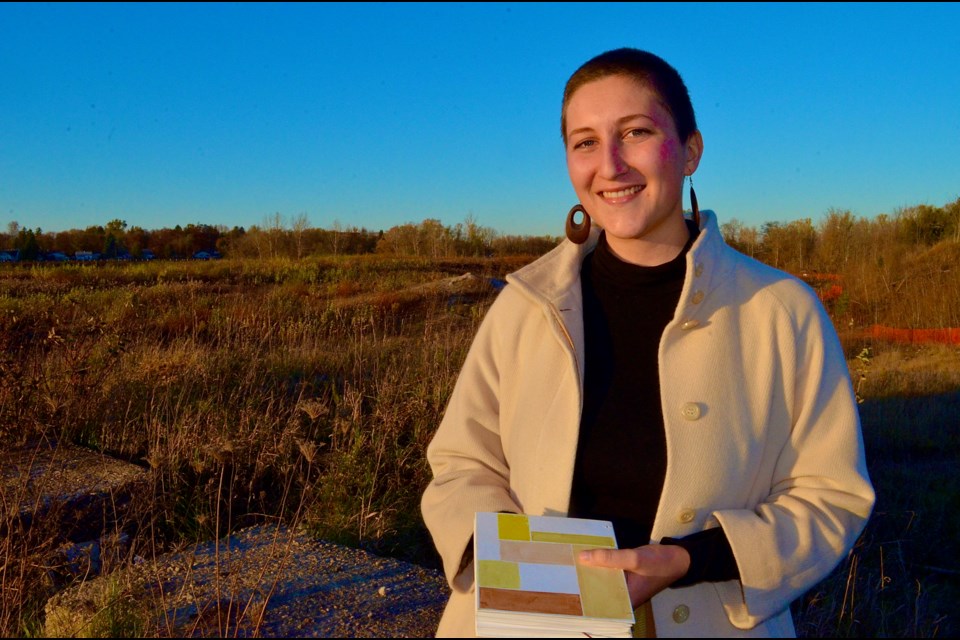Keeping up with the latest clothing trends can be an expensive pursuit for fashion-conscious consumers, but there is also a hidden cost to the environment that we all pay.
“There is so much waste in the textile industry,” said Guelph musician and artist Anita Cazzola. “The vast majority of our clothes are dyed with synthetic dyes and there is a ton of chemical runoffs from those processes."
Finding natural alternatives to synthetic dyes is the idea behind Botanical Reclamation, a project Cazzola recently initiated using wild plants she found growing at the former Lafarge gravel quarry near her home.
“I just moved to the neighbourhood this past winter and I started coming here in the summertime,” she said. “I noticed so many beautiful wildflowers growing. At first, I was just picking them and bringing beautiful bouquets home and then I started to realize how many of these plants could be used as natural dyes for textiles.”
Many in the city know Cazzola as one half of the singing sister duo The Lifers with her sister Liv Cazzola, as well as for her collaborations with singer-songwriters Annie Sumi, Sam Boer and others.
She is also an award-winning textile and installation artist who was selected this week by the Guelph Arts Council to share the Jane Graham Memorial Award with illustrator Abby Nowakowski. Cazzola plans to use her share of the award money to help fund the Botanical Reclamation project.
Cazzola is a graduate of the Ontario College of Art and Design and recently completed a two-week natural-dye workshop at Haystack Mountain School of Crafts in Maine led by Kathy Hattori from Botanical Colors, a natural dye company in the US.
“It was such an amazing experience learning all the steps and all the unknowns, as well, of natural dye,” said Cazzola. “Finally, this summer I just thought I want to do this anyway, why not focus on a specific site and just really try to engage with those plants in more ways than just getting colour.”
The former quarry on a closed-off stretch of Silvercreek Parkway South appealed to her social, environmental and artistic sensibilities.
“I have always been attracted to really, sort of sad spaces,” she said. “Any kind of space that is in transition or has been sort of forgotten and not treated with the respect or reverence it deserves.”
The man-made ponds at the 16.5-hectare site were popular with swimmers during the latter half of the 20thCentury when the quarry was in operation. When gravel extraction ceased, Mother Nature slowly reclaimed the land and, despite being private property, it became popular with hikers, off-road cyclists and dog walkers.
In the summer of 2017, to discourage public use and prepare the property for development, the city approved a request to remove nearly 2,000 trees and bulldoze the myriad trails crisscrossing the site. Local activists organized a protest to stop the plan but it proceeded.
“I called the city and asked for details about the history of the site,” said Cazzola. “Just knowing it was quarried for 20 years, at least, and had multiple clear cuts and total bulldozing and yet all of these amazing plants are still thriving and still giving is just incredible. I just thought I have to amplify their voices in a way that feels like I am helping to spread awareness about their existence and importance.”
Among the plants she has experimented with are goldenrod, sumac, aster, willow, dandelion and St. John’s Wort.
“So much of it is a mystery until it is happening because there are so many factors that could change the results like mineral content in the water you are using, soil content that the plants are absorbing as they are growing, how you pre-treat the fibres,” she said. “Any plant that is rich in tannin will probably give you a good colour.”
She has also researched each plant's role as food for wildlife and their natural medicinal qualities.
“Not only are they beautiful but they are really, really important for pollinators and a whole variety of ecosystem inhabitants,” she said. “The sad thing about this sort of site is the plants can’t be harvested for medicine because I don’t know what has been happening to the soil given that it was a quarry.”
Cazzola is inviting people to join her at the site on Sat. Nov 14 and Sunday, Nov 15 between 10 a.m. and 5 p.m. where she is staging a textile installation.
“Basically, with all these dye tests I’ve done I have patched all these pieces of fabric together into this sort of flag type textile that I am going to hang here,” she said. “It is kind of the first work of several I am hoping to make into next year just to have more of an integrated installation into different areas of the site.”
She expects the Botanical Reclamation project to take two years but hopes her work will illustrate the value of preserving the natural elements of the site when development proceeds.
A large sign at the entrance to the site near the intersection of Eden Place and Silvercreek Parkway South shows the plan for a proposed development that would include a mix of residential and green space.
“I kind of feel a little bit of pressure because I do know there is potential for development as soon as possible next year,” she said. “I guess a partner piece of this project is more of a civic engagement sort of thing for me. I would love to be able to participate in meetings and things to try and advocate for keeping these plants alive even if this space is developed.”
To learn more about the project visit: https://www.facebook.com/events/355409929051300 or https://anitacazzola.com/botanical-reclamation



